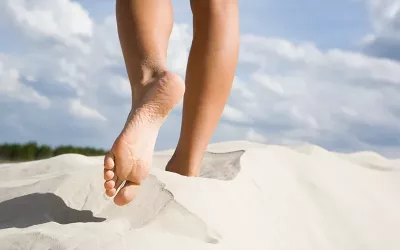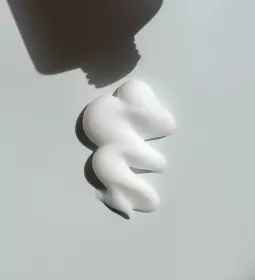When I (Heath) was a teenager, I remember the strange experience of being told by my pediatrician that the arch of my left foot had collapsed since my last annual exam. He wasn’t concerned, but he advised me to keep watch on it.
In my 20s, I began to give closer attention to the shape of my toes and feet and realized that they were starting to twist in the same way I’d seen with my mom’s and my grandfather’s feet—what’s called hammertoes and mallet toes were beginning to take residence in my fourth, middle, and second toes. I was alarmed and wondered, “If this is happening to me now, what will my feet be like in the decades to come?”
What I discovered decades later was the possibility and reality that I can change the shape of my feet without surgery. I am happy to report and share with you how I have regrown my arch and lengthened my toes with a dedicated practice of what I now call “future-proofing.”
Our feet are meant to carry us through all stages of life. But often, we don’t take care of our feet until they hurt. What if we took care of our feet, not because they are hurt or in need, but simply because they want our attention and support? What might it look like to future-proof our feet?
Future-proofing our feet builds strength, mobility, and resiliency to protect, support, and prepare our feet for whatever and wherever your feet take you, from walking to the mailbox to navigating through a bucket list of world destinations. We can create happy feet at any age to last a lifetime.
Don’t wait for an injury to care for your feet! When we take time to refine how we walk, stand, and move, we can prevent trouble before it arises.
Did you know that your feet absorb a force equivalent to 4–6 times your body weight with each step you take while walking? That impact increases dramatically to 11 times your body weight when you run.¹ And it’s the tiny muscles or your “foot core” that are responsible for absorbing that load and providing stability for a pain-free experience in every step, jump, hop, and skip. Ideally, your foot acts as a tripod when you stand, distributing weight between the ball of your big and little toe and the heel. And in a perfect world, you use the big toe for forward propulsion. If the arch or big toe muscles become weak, a chain reaction occurs causing localized foot pain as well as pain felt in the structures above, including the ankles, knees, hips, and low back.

Don’t wait for an injury to care for your feet! Instead, prevent trouble before it arises. When we take time to refine how we walk, stand, and move from the floor to the core, we keep ourselves moving through life with grace and ease. Experiment and practice some outstanding healing moves for your feet below.
Exercises for Your Feet
Walk in Nature
Put your feet (preferably bare feet) in the sand, take a forest walk, or run across grass to offer dynamic terrain that will challenge your feet to stabilize, grip, and actively adapt to natural, nonlinear surfaces.
Do a First Aid Foot Roll
This is a good exercise for minor foot, ankle, or knee pain. If your joint feels slightly off, step back with the challenged foot (about 2 feet), with your feet shoulder-width apart. Begin to roll through the back foot from heel to toes then reverse, shifting your body from the front foot to the back foot. Repeat about six times, emphasizing the toe stretch. (Scan the QR code on page 57 to follow along.)
Work on Balancing
Maintaining your balance is essential at any age to avoid falls, improve coordination, and feel confident in your body. Try one-legged calf raises.
Walk Backwards
This is an easy and fun way to strengthen the tibialis anterior and the big toe. To quote Ben Patrick (@kneesovertoesguy), “Your feet and ankles cannot be too strong for what’s above.”
Try Big Toe Lifts
“Toe weakness is the single biggest predictor of falls when we get older, according to a study in Clinical Biomechanics.² Strengthen the toes, reinforce the arch of the foot, and aid toe dexterity by raising the big toe while keeping the other toes on the floor. Avoid scrunching the toes or foot while lifting the big toe in this exercise.
Do a Kneeling Toe Curl
Stretch and strengthen your plantar fascia by sitting on your heels. This is the move I used over the course of years to help regrow my collapsed arch and straighten out my bent toes. It may seem counterintuitive that stretching your plantar fascia actually strengthens it. But when you consider the physiological imperative that “stress builds tissue,” functional stretches (particularly with added load) can help build muscle tone. This may also generate a higher arch.
Begin on the floor on your hands and knees and curl your toes under your feet. Start to reach your seat back toward your feet and gently leverage more body weight into the feet. Be sure there is no pain in your knees, and if there is pain, skip this exercise until it feels doable. You might only be able to hover with your seat a few inches above your curled toes, or you might be able to (immediately or over time) rest your seat and entire upper body weight on your heels for a few seconds. You can practice building up to several minutes. Over time, see if you can sit all the way up on your heels. Be sure only to perform the intense version if it feels safe for your knees. For more support and while you are building up your stamina, flexibility, and resilience, use a yoga block or pillow between your seat and feet for added safety and bolstering.
The more you move your feet now, the more you’ll be able to move them later with less pain, more confidence, more stability, and more ease. Wishing you a lifetime of happy feet!
Notes
1. Jen Murphy, “A 12-Minute Workout to Build Foot Strength,” The New York Times, July 18, 2024,
www.nytimes.com/2024/07/18/well/move/foot-workout-exercises.html.
2. K. J. Mickle et al., “ISB Clinical Biomechanics Award 2009: Toe Weakness and Deformity Increase the Risk of Falls in Older People,” Clinical Biomechanics 24, no. 10 (December 2009): 787–91, https://doi.org/10.1016/j.clinbiomech.2009.08.011.









